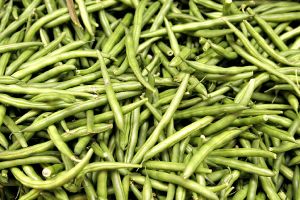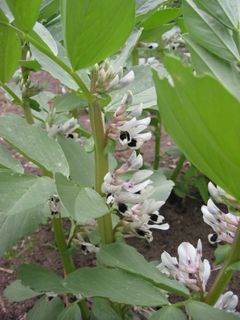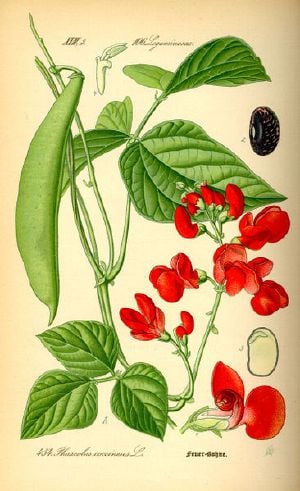Bean
Bean is a common name for large plant seeds of several genera of Fabaceae (formerly Leguminosae) used for food or feed. The various species of bean bean plants include some of the very first plants cultivated by man in both the Old and the New Worlds. They have been and continue to be an important part of the human food supply.
Name
Bean originally meant the seed of the broad bean, but was later broadened to include members of the genus Phaseolus such as the common bean or haricot and the runner bean and the related genus Vigna. The term is now applied in a general way to many other related plants such as soybeans, peas, lentils, vetches and lupines. Bean can be used as a near synonym of pulse, an edible legume, though the term "pulses" is usually reserved for leguminous crops harvested for their dry grain. Pulses usually excludes crops mainly used for oil extraction (like soybean and peanut) or those used exclusively for sowing purposes (clover and alfalfa). Leguminous crops harvested green for food like snap beans, green peas etc. are classified as vegetable crops.
In English usage beans sometimes also refer to seeds or other organs of non leguminosae, for example coffee beans, castor beans and cocoa beans (which resemble bean seeds), and vanilla beans (which resemble the pods).
Broad beans
Vicia faba, the broad bean, fava bean, faba bean, horse bean, field bean or tic bean is a species of bean (Fabaceae) native to north Africa and southwest Asia, and extensively cultivated elsewhere. Although usually classified in the same genus Vicia as the vetches, some botanists treat it in a separate monotypic genus as Faba sativa Moench.
It is a rigid, erect plant 0.5-1.7 m tall, with stout stems with a square cross-section. The leaves are 10-25 cm long, pinnate with 2-7 leaflets, and of a distinct glaucous grey-green colour; unlike most other vetches, the leaves do not have tendrils for climbing over other vegetation. The flowers are 1-2.5 cm long, with five petals, the standard petal white, the wing petals white with a black spot, and the keel petals white. The fruit is a broad leathery pod, green maturing blackish-brown, with a densely downy surface; in the wild species, the pods are 5-10 cm long and 1 cm diameter, but many modern cultivars developed for food use have pods 15-25 cm long and 2-3 cm thick. Each pod contains 3-8 seeds; round to oval and 5-10 mm diameter in the wild plant, usually flattened and up to 20-25 mm long, 15 mm broad and 5-10 mm thick in food cultivars. Vicia faba has a diploid (2n) chromosome number of 12, meaning that each cell in the plant has 12 chromosomes (6 homologous pairs). Five pairs are acrocentric chromosomes and 1 pair is metacentric.
Cultivation and uses
Broad beans have a long tradition of cultivation in Old World agriculture, being among the most ancient plants in cultivation and also among the easiest to grow. It is believed that along with lentils, peas, and chickpeas, they became part of the eastern Mediterranean diet in around 6000 B.C.E. or earlier. They are still often grown as a cover crop to prevent erosion because they can over-winter and because as a legume, they fix nitrogen in the soil.
In much of the world, the name broad bean is used for the large-seeded cultivars grown for human food, while horse bean and field bean refer to cultivars with smaller, harder seeds (more like the wild species) used for animal feed, though their stronger flavour is preferred in some human food recipes, such as falafel. The term fava bean (from the Italian name fava) is commonly used in the United States.
Culinary uses
Broad beans are eaten while still young and tender, enabling harvesting to begin as early as the middle of spring for plants started under glass or over-wintered in a protected location, but even the maincrop sown in early spring will be ready from mid to late summer. Horse beans, left to mature fully, are usually harvested in the late autumn.
The beans can be fried, causing the skin to split open, and then salted to produce a crunchy snack. These are popular in China, and also in Thailand where their name means "open-mouth nut".
Health issues
Broad beans are rich in tyramine, and thus should be avoided by those taking monoamine oxidase inhibitors. They contain vicine and convicine, which can induce hemolytic anemia in patients with the hereditary condition glucose-6-phosphate dehydrogenase deficiency (G6PD). This condition, which is quite common in certain ethnic groups, is called "favism" after the fava bean.
Broad beans are rich in L-dopa, a substance used medically in the treatment of Parkinson's disease. L-dopa is also a natriuretic agent, which might help in controlling hypertension.[1]
Chick peas
Soybeans
New World beans
Common beans
Runner beans
The runner bean (Phaseolus coccineus, Fabaceae) is often called the scarlet runner bean since most varieties have red flowers and multicolored seeds, though some have white flowers and white seeds. It is native to the mountains of Central America.
The runner bean differs from the common bean in several respects: the cotyledons stay in the ground during germination, and the plant is a perennial with tuberous roots (though it is usually treated as an annual).
The green pods are edible whole but in some varieties (the scarlet runner) tend to become fibrous early, and only the seeds within are eaten. The seeds can be used fresh or as dried beans. The starchy roots are still eaten by Central American Indians. The scarlet runner is widely grown for its attractive flowers by people who would never think of eating it.
Phaseolus coccineus subsp. darwinianus is a cultivated subspecies of P. coccineus, it is commonly referred to as the Botil bean in Mexico.
ReferencesISBN links support NWE through referral fees
- Beans for the home gardener
- Everett H. Bickley Collection, 1919-1980 Archives Center, National Museum of American History, Smithsonian Institution.
- Bean facts and photography
- Discovery Online: The Skinny On Why Beans Give You Gas
- Bulgarian Guide: Bean Soup Recipe
- Watson, R., 2004 "A Closer Look at Legumes" Mediterrasian.com[1]
Credits
New World Encyclopedia writers and editors rewrote and completed the Wikipedia article in accordance with New World Encyclopedia standards. This article abides by terms of the Creative Commons CC-by-sa 3.0 License (CC-by-sa), which may be used and disseminated with proper attribution. Credit is due under the terms of this license that can reference both the New World Encyclopedia contributors and the selfless volunteer contributors of the Wikimedia Foundation. To cite this article click here for a list of acceptable citing formats.The history of earlier contributions by wikipedians is accessible to researchers here:
The history of this article since it was imported to New World Encyclopedia:
Note: Some restrictions may apply to use of individual images which are separately licensed.
- ↑ Vered Y, Grosskopf I, Palevitch D, Harsat A, Charach G, Weintraub MS, Graff E. The influence of Vicia faba (broad bean) seedlings on urinary sodium excretion. Planta Med 1997;63:237-40. PMID 9225606.


